The Washington Nationals season has been full of ups and downs. A brutal start to the season had many asking whether future Hall of Famer Max Scherzer would be traded away at the deadline. Then a historic stretch of baseball from Kyle Schwarber propelled the Nationals back into the thick of the NL East divisional race only to eventually run into an unstoppable force that is the Los Angeles Dodgers. The Nationals were swept in a four-game weekend series that saw their All-Star shortstop hurt with an injured finger, and Schwarber leaves a game with an apparent hamstring injury. There were few bright spots in the series with the defending World Series champs, but one bright spot was Joe Ross. The Nationals announced he would make the rotation at the beginning of the year and while his season, much like the Nationals, has been up and down, Ross may have discovered an approach that could lead to sustainable success. He’s also capable of much more. Assuming his stint on the IL is a short one, Ross is primed for a full breakout in the second half.
All statistics are up to date through Thursday, July 8th. The statistics and rankings do not include games played on July 8th.
Executing the Game Plan
Every pitcher has a game plan. They all look at scouting reports and understand hitter’s tendencies but oftentimes, pitchers will play to their strengths even if the hitter is good against those strengths. CC Sabathia and Blake Snell have talked about this on Snell’s appearance on R2C2. Understanding that game plan is important. For Joe Ross, who has 4 pitches, a sinker, four-seam fastball, slider, and changeup, the game plan is unique. While most sinker-heavy pitchers work towards pitching to contact, Ross doesn’t pitch in that same sort of way. Ross has generated a respectable 43.3% ground ball rate but not what you’d expect from somebody who throws so many sinkers. The two biggest reasons for that are how the pitch moves and when it’s thrown.
Ross’s sinker on paper looks like a below-average pitch. It moves in pretty much average ways compared to other sinkers at his velocity, and he doesn’t generate a lot of weak contact with the pitch. When Ross first came up, the pitch had a lot of horizontal movement on the ball with average vertical movement. He has sacrificed some run on the ball to get more vertical movement, but it hasn’t made the pitch move more. So being able to locate that pitch well would be important, keeping it down to the hitters will make it generate some weak contact but Ross doesn’t do that. Here’s his heat chart in all counts with his sinker.
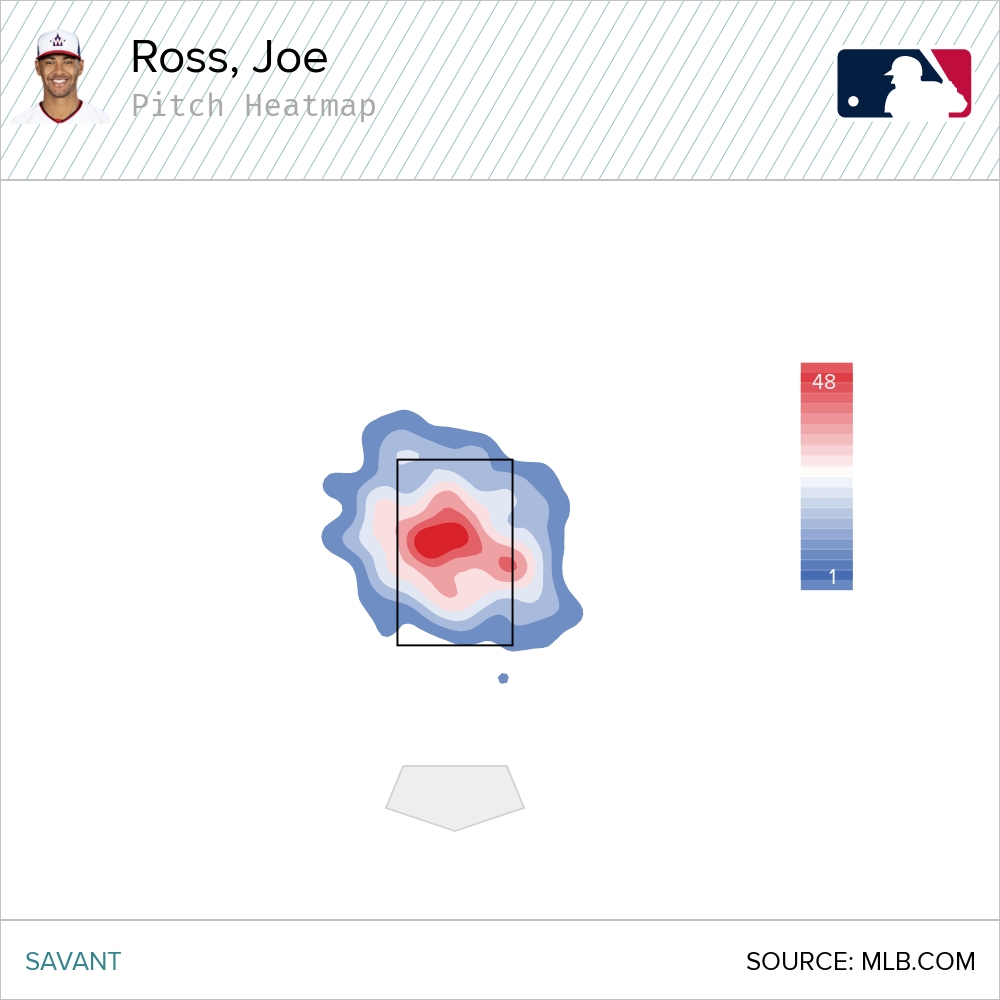
Ross throws his sinker right down the middle a lot. In theory, you’d expect the pitch to get hammered a lot and while Ross does give up some hard contact with the pitch, He has amassed an RV of -8 with the pitch this year. It’s because almost two-thirds of Ross’s sinker come on either the first pitch or when he’s behind in the count. He throws it down the middle to try and get a swing or get back in the count. Here’s his heat map on 0-0 count.
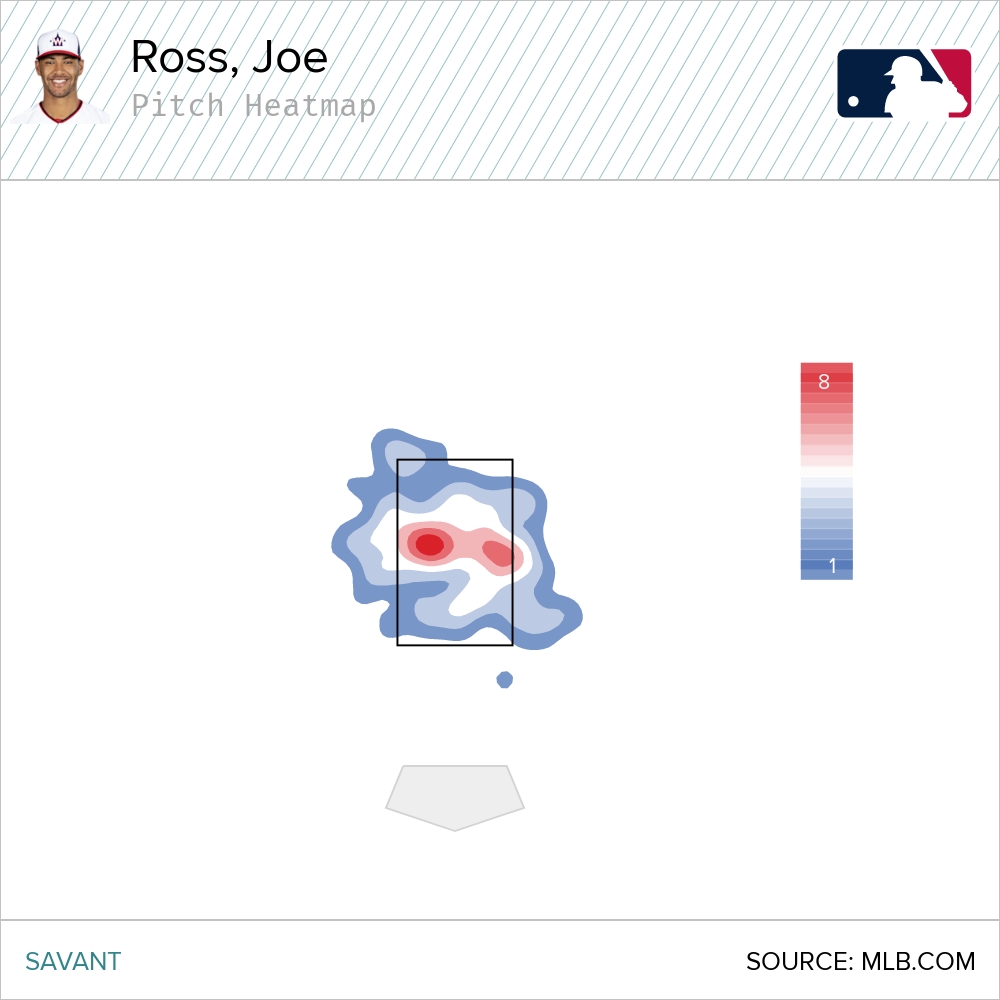
Here’s his heat map when he’s behind in the count.
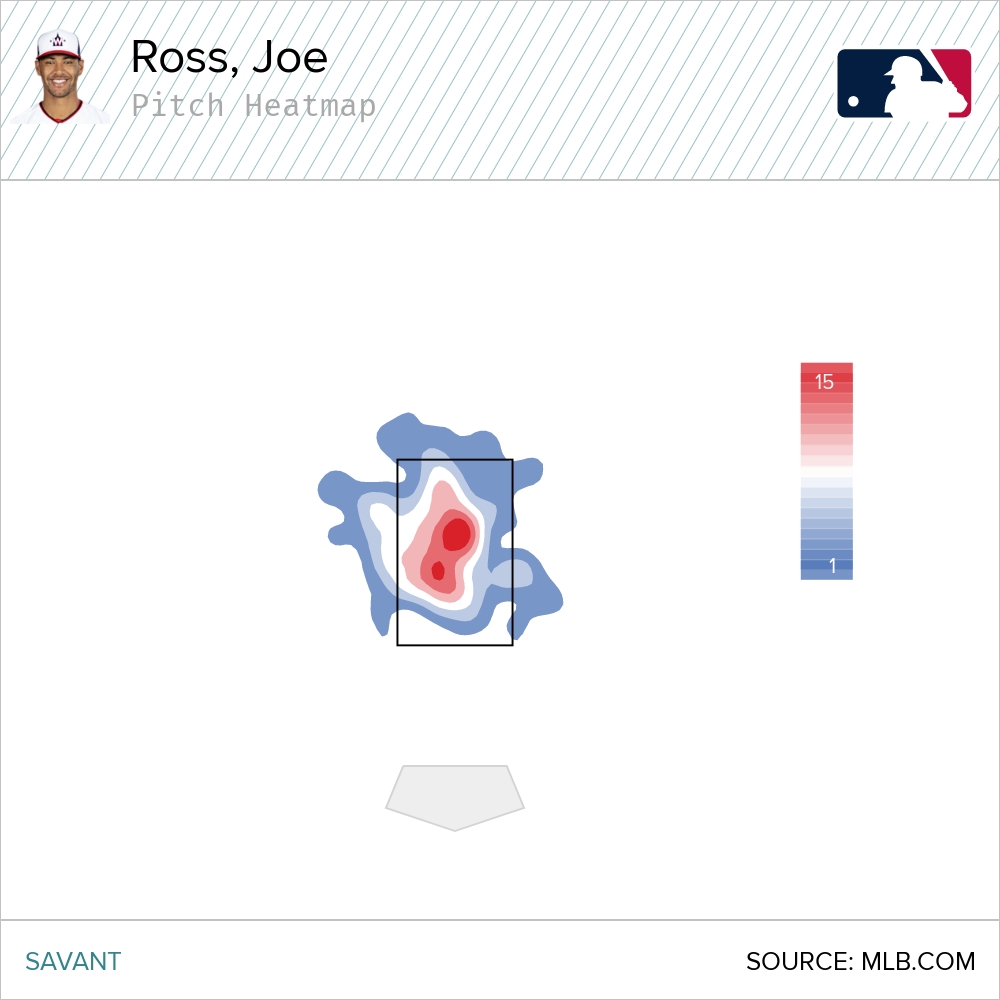
One of the biggest parts of Ross’s game plan is to use his sinker, not as a ground ball pitch, but a setup pitch for his four-seam fastball and slider. It’s worked for him so far and Ross’s problems don’t typically stem from poor location from his sinker. It stems from poor locations with his other pitches.
To begin with his other pitches, I’ll start with his slider. Again, much like his sinker, it moves like an average to a below-average pitch. Yet, he’s improved its movement characteristics over the years and that has helped Ross become more comfortable with the pitch. It’s possible that he has changed the grip on the pitch or adjusted the way he maneuvers the seams, but he’s turned it into a formidable pitch generating a 16% swinging strike on it, second-best in his arsenal. He also has the lowest wOBA and xwOBA of his arsenal on the pitch. His approach is clear with the pitch, throw it down and away to righties as much as possible and mix it in and out to lefties. Here’s the heat map versus righties

Here’s his heat map to lefties.
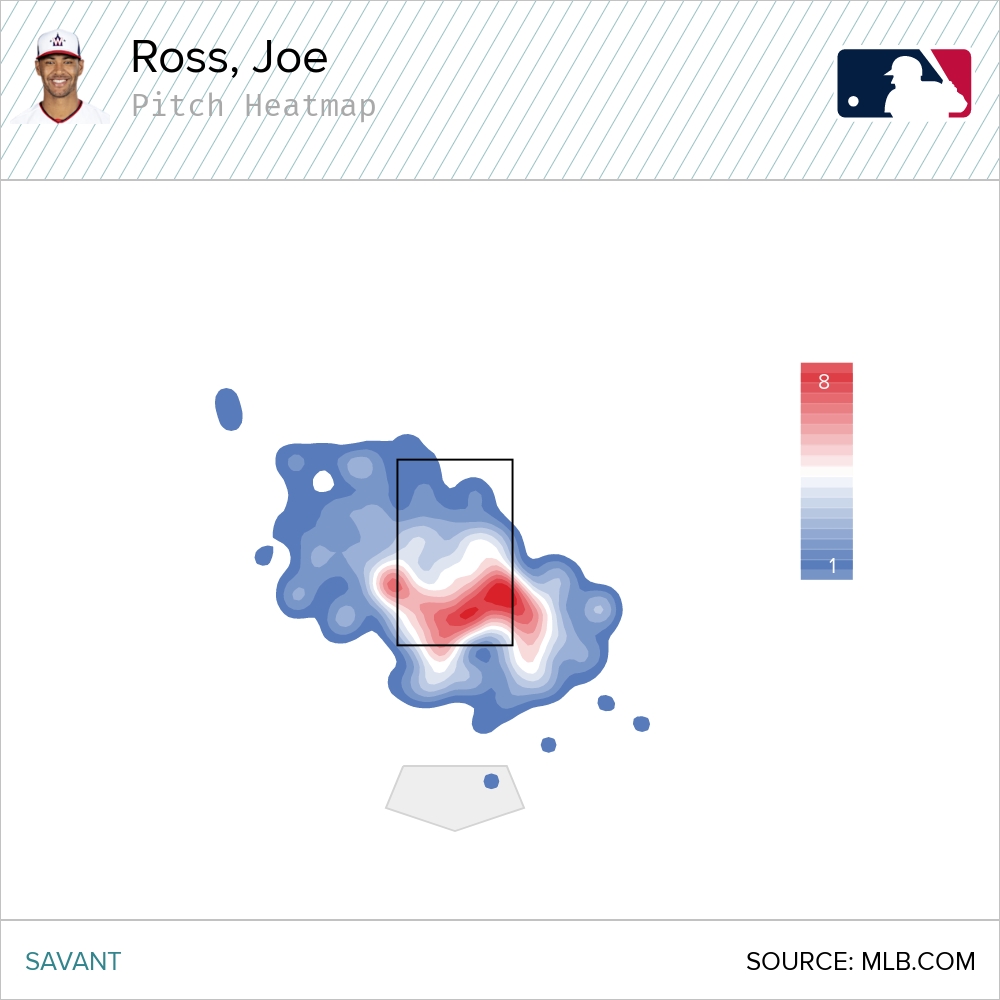
Ross is using his slider as primarily an out pitch and nearly 40% of his sliders have come when he’s ahead in the count. Ross’s slider can get punished when it’s left in the strike zone as the three home runs he’s allowed on the slider have all come on roughly the same spot in the strike zone. Keeping that pitch out of the zone or on the edge of it will be important to his success. He uses the sinker to try and set up the low and away slider to righty or back door slider to leftie or down and in slider to a leftie. If he can’t generate the swing and miss there he’s going to move towards his four-seam fastball.
Ross doesn’t throw his four-seam fastball much and when he does throw it, it’s in the same situation in the same spot. He throws it up in the zone and primarily with two strikes. He’s thrown 100 of his 238 four-seam fastballs with two strikes. He’s only started 44 hitters with a first-pitch fastball, so it’s his primary swing and miss pitch. Ross doesn’t spin the ball great but his command of the high fastball is good enough to throw it up in the zone and be effective. Here’s his heat map of four-seam fastballs with two strikes.
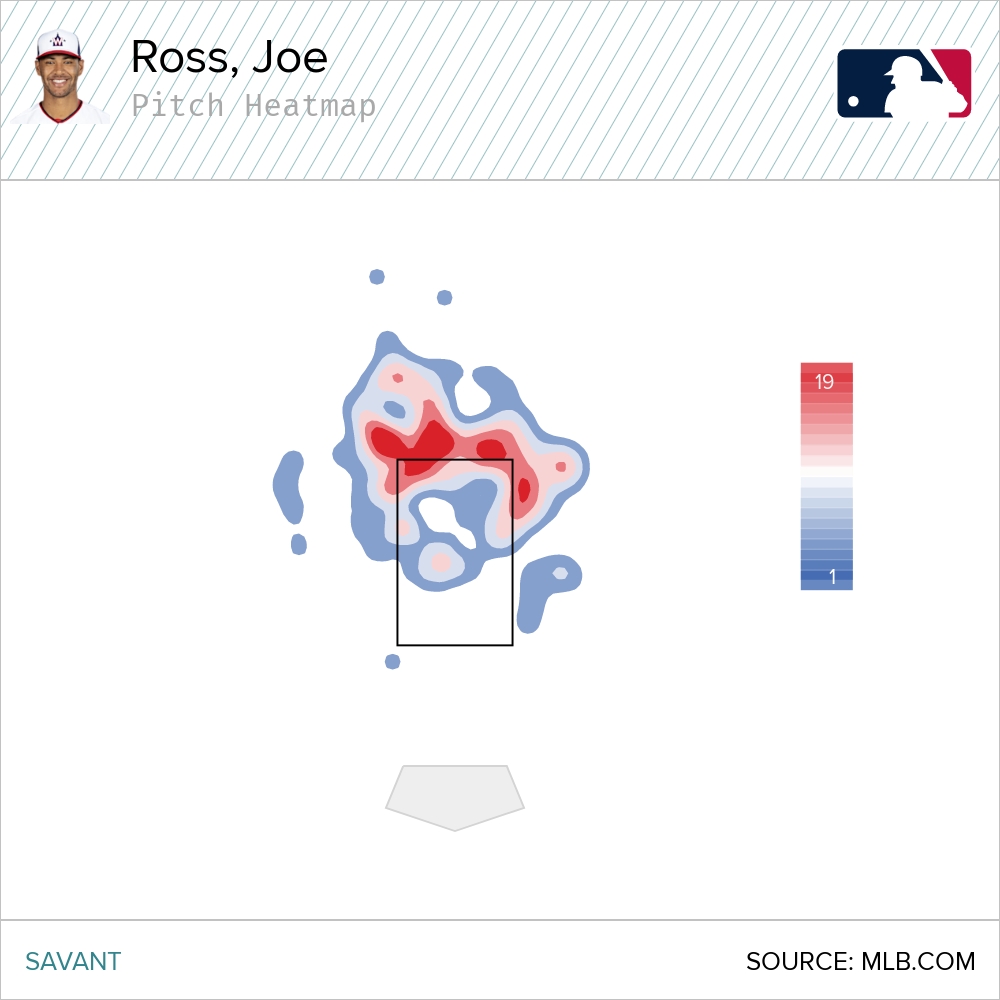
Ross has only given up one home run on a high fastball this year and it was in the strike zone. When he keeps it there it’s effective. And that’s the issue for Joe Ross. His game plan is to get ahead with sinkers and sliders in the zone and finish hitters off with a slider out of the zone or back door slider or high fastball. His problem is that he can’t execute that game plan consistently. He will leave fastballs over the middle of the plate sometimes or sliders over the middle of the plate. His sinker can get walloped sometimes for the same reason. He has an 8.3 meatball% which is too high. Yet, he’s starting to work on those things slowly and he’s seeing some improvements.
Trending Forward
This past Sunday, Joe Ross worked 6 innings of one-run baseball against one of the best offenses in baseball. Coming out for the 7th inning showed a serious amount of faith in Ross, one he might be earning. While he did allow another run to come in to score and then eventually Brad Hand let in another run in the inning, Ross’s three earned runs didn’t reflect the game that he pitched. It was the third double-digit strikeout game of his career and his first since 2017 against the Orioles. It wasn’t his best start of the month, but it was the start the probably caught the most attention as it continued what has been a month of great pitching. Here are Joe Ross’s ranks among qualifiers since the beginning of June.
Photo by Mark Goldman/Icon Sportswire | Design by Michael Packard (@designsbypack on Twitter @ IG)
